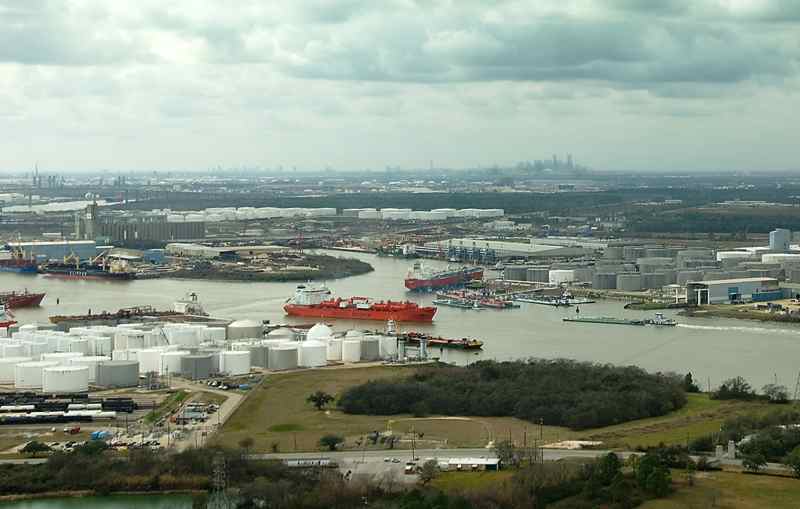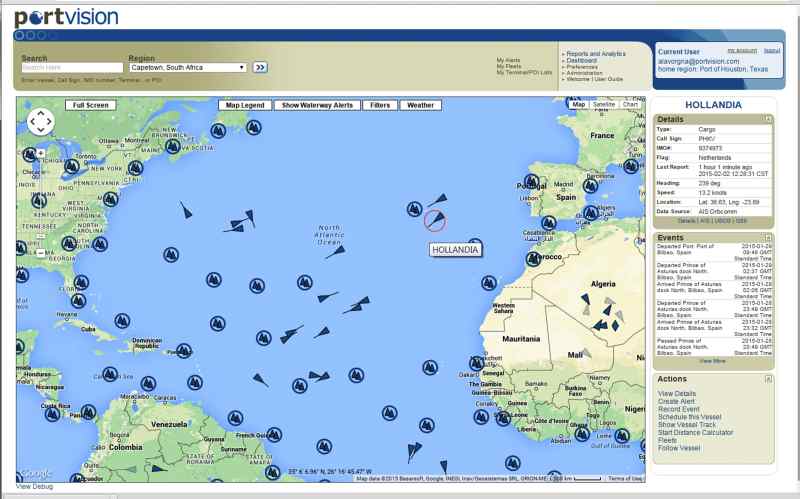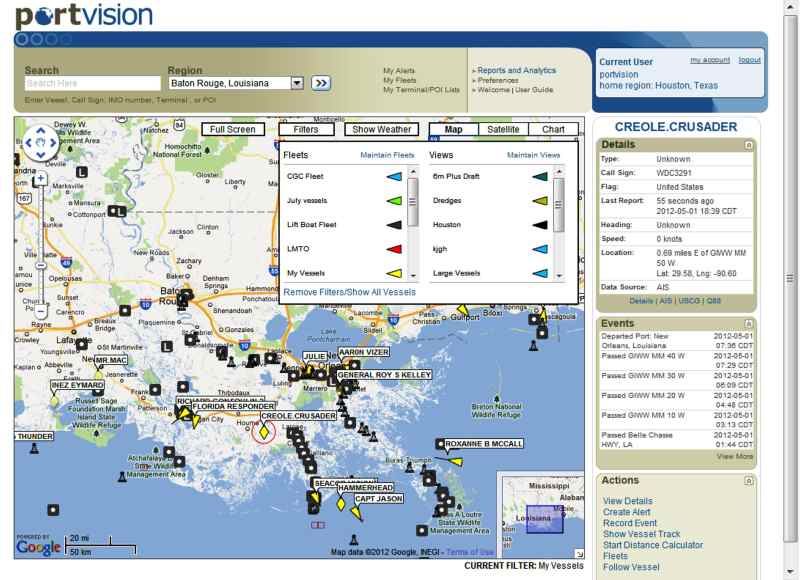October Feature Story - Portvision
U.S. Coast Guard Regulations Expand AIS Carriage, Create New Opportunities to Improve Maritime Operations
By Jason Tieman, Oceaneering Director of Maritime Operations GDS
The U.S. Coast Guard recently completed the expansion of its Notice of Arrival (NOA) regulatory requirements, originally created in 2008. The goal was to help address threats to maritime transportation safety and security by improving navigation safety, enhancing the ability to identify and track vessels, and heightening overall Maritime Domain Awareness (MDA). Among other changes, the Final Rule (80 Fed. Reg. 5281), passed on 30 January 2015, expands the applicability of both NOA and Automatic Identification System (AIS) requirements to include more commercial vessels. In addition to meeting the Coast Guard’s safety and security objectives, these changes will also make it easier to realize the many additional benefits of AIS data for providing instant, continuous access to critical information about vessel activities at sea, in ports, and at busy marine terminals.

Understanding the New Requirements
Written into the Federal Register, Volume 80, Number 20, the U.S. Coast Guard’s Final Rule became effective 2 March 2015 (except for amendments to 33 CFR part 160 that became effective 30 April). In addition to improving security, safety, and environmental protection in U.S. ports, the Coast Guard believes that the Rule will enhance maritime and navigational safety through the synergistic effect of NOA and AIS as well as the ability to monitor vessel-specific movements in real time. AIS data will also enable the authorities to quickly locate, track, and intercept vessels, if necessary, due to security risks.
Among its provisions, the rule expands the requirement for NOA to include commercial vessels 300 gross tons or less that come to the U.S. from a foreign port (or place) and covers all U.S. navigable waters or deepwater ports. It also sets forth a mandatory method for electronic Notice of Arrival and Departure (NOAD) submission and modifies related reporting content, timeframes, and procedures. Five new data fields are required: a vessel’s Maritime Mobile Service Identity (MMSI) number; whether a vessel is 300 gross tons or less; whether a voyage is less than 24 hrs; the last port of departure; and the arrival and departure date for the last port of departure.
The Coast Guard estimates that 3,430 U.S.-flag and 14,947 foreign-flag vessels will be affected by the NOA requirement. Certain salvage vessels, submersible vessels, and ferries on fixed routes are exempted. The new vessels required to install AIS include self-propelled commercial passenger or fishing vessels (i.e., crew boats) that are 65 ft or more in length, a self-propelled vessel engaged in dredging operations, and a self-propelled vessel engaged in the movement of certain dangerous cargo (CDC) such as that defined in subpart C of 46 CFR part 160 or flammable or combustible liquid cargo in bulk that is listed in 46 CFR 30.25–1, Table 30.25–1.

The Final Rule also requires electronic submissions to expedite processing of NOAD information, including data about a vessel, its voyage, cargo, and persons on board. The Coast Guard may also create regulations that require receipt of pre-arrival messages from vessels on their way to the U.S. in order to permit advanced vessel traffic planning (access the Electronic Notice of Arrival/Departure – eNOAD site at https://enoad.nvmc.uscg.gov/).
Additionally, AIS must now be installed and in operation on most commercial vessels when on the navigable waters of the U.S., and AIS installations must be completed within 18 months. Smaller vessels will not need to adhere to the additional AIS-related requirements, but all vessels moving dangerous cargo must be equipped with AIS, no matter their size. The rule extends AIS requirements beyond Vessel Traffic Service (VTS) areas and non-VTS users to include all U.S. navigable waters or deepwater ports. The Coast Guard estimates that the new AIS provisions will affect 5,848 U.S. vessels and 74 foreign-flag vessels.
Finally, the rule also allows for AIS to be installed on offshore fixed structures. Previously, AIS Aids to Navigation (ATON) systems were prohibited on certain fixed structures, such as bridges. This is now allowed. The reasoning is that the primary benefit of AIS is to provide near real-time dynamic information. Fixed and charted structures do not move; however, some are used by vessels as navigational aids based on their position and proximity to shipping lanes. This Final Rule recognizes that reality.

Additional Value of Increased AIS Carriage
An added benefit of the new regulation is that it increases visibility of vessel movements within Electronic Chart Display and Information Systems (ECDIS), VTS, and shore-side systems such as Oceaneering’s PortVision® Plus and PortVision® Advantage. While the Coast Guard has mandated AIS use since 2005 for safety and security purposes, these other systems have been using AIS data to help solve difficult operational challenges. Typical applications include scheduling of vessels at an oil refinery, supporting an incident response operation, providing post-mortem compliance, legal or training support, and supporting homeland security and law enforcement activities.
As an example, the PortVision® web-based enterprise software and services platform leverages instant, continuous access to critical real-time and historical AIS information about vessel and terminal activities in order to provide government users, marine terminal operators, fleet owners/operators, and other maritime users comprehensive tools for improving their business operations. The platform has become one of the most widely adopted enterprise-class marine terminal optimization solutions for oil companies who have been under growing pressure to streamline operations, reduce costs, increase visibility, and enhance business intelligence. It helps these organizations achieve their objectives by automating collaborative scheduling, reporting, analysis, and decision-making functions for managing terminal and fleet operations.
During the past year, AIS has also been adopted as a major weapon in the fight to protect pipeline infrastructure, greatly improving safety for mariners transiting and operating in close proximity to them. The Coastal and Marine Operators (CAMO) has launched a pipeline encroachment monitoring and vessel alerting program at Port Fouchon that uses AIS data for this purpose. A broader initiative implemented by Kinetica LLC enables the company to better target public outreach efforts to connect with specific vessel operators while more efficiently allocating resources for pipeline integrity management across their entire pipeline infrastructure. For the latter effort, Kinetica uses AIS data to generate the necessary analytics about historical vessel traffic over its pipeline system so it can optimize decision-making around infrastructure inspections, permitting, and planning.
In another example, a top-3 oil company is combining AIS with radar, VHF communications, and other data sources into a single command-and-control platform with the necessary intelligence to predict, recognize, and issue alerts when there is imminent danger of a remote asset strike anywhere in the organization’s extensive infrastructure. This program establishes a virtual “watch team” over multiple remote assets anywhere in the world.
The asset protection benefits of AIS do not stop with pipelines. The concept can also be extended to subsea cable and other remote un-manned assets. With the Final Rule’s provisions for ATONs on certain fixed structures, such as bridges, it is not hard to imagine how AIS could be used to prevent damage to an even broader range of assets and infrastructure types while significantly improving their monitoring and maintenance.
Value-added AIS benefits are only possible if carriers transmit a persistent AIS signal with accurate data. By adding AIS carriage, the U.S. Coast Guard’s Final Rule will not only increase security, safety, and environmental protection in U.S. ports, but also create new opportunities to promote AIS data’s benefits across many types of operations.
For more information, visit www.portvision.com.

